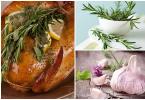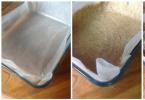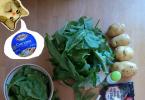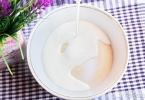Tea is one of the most popular drinks in the world. You make it by pouring hot water over the dried leaves of a tea plant. For centuries people believed that teas could cure illnesses, they used it as medicine. Today scientists know that tea contains chemicals that prevent cells from dying. Most teas have caffeine in them, a substance that makes you feel more active. Some people have problems drinking tea because it can cause sleeplessness.
Tea plant
The tea plant grows best in tropical and temperate places where rain falls throughout the year. Tea can be grown from sea level to about 2,000 metres, but the best quality grows in higher regions.
Tea comes from the leaves and buds of tea plants. Wild plants can be up to 9 metres high but on tea plantations they are cut back to a bush of about a metre in height so that workers can pluck the leaves easily. The plant produces pointed, leathery dark leaves, small white flowers and seeds that look like hazelnuts. It takes a plant three to five years before is ready for plucking.
A plucker can harvest about 20kg of tea a day. On large tea plantations the leaves are harvested by machines, but the quality of tea is higher when the leaves are hand-plucked.
Types of tea
The most common types of tea are black and green tea. They come from the same plant but are processed differently.
Workers take the leaves and spread them out on shelves where they can dry. Next, they are rolled and broken into pieces and put into a room where they absorb oxygen. Chemical reactions change the taste and character of the tea. Finally, the leaves are dried with hot air until they turn brownish-black. Most black tea comes from Sri Lanka, Indonesia and eastern Africa.
To make green tea, workers put the freshly picked leaves into a steamer, which keeps them green. Then they are crushed and dried in ovens. Japan is the biggest producers of green tea.
Tea can be bought in many forms – leaves, powder or tea bags. Some of them are added with flavours, like vanilla, orange or lemon. Although most people drink their tea hot, many enjoy iced tea, especially during the summer months.
Black tea is brewed by pouring water over a teaspoon of tea. The tea should soak for three to five minutes before you drink it. Green tea should be left in water longer. Instead of putting tea leaves into a pot people often put tea bags into a cup.
History
People first drank tea in China about 5000 years ago. Originally it was used as a medicine, then as a daily drink. It spread to Japan in the 3rd century A.D. Dutch and Portuguese traders brought tea from eastern Asia to Europe in the 1600s.
In 1657 the beverage was sold for the first time in coffee houses in Great Britain. When the English started a tradition of tea drinking in the afternoon it became England"s national drink. In the 17th and 18th centuries tea spread to British colonies overseas.
In 1767 Great Britain placed a tax on tea imported by American colonists. During the Boston Tea Party of 1773 they were so angry that they threw a ship full of British tea into the harbour to protest British rule. Two years later the American Revolutionary War started.
Today about 3.3 million tons of tea are produced. India, with its famous tea growing regions like Darjeeling and Assam, and China produce about half of the world"s tea. It also grows in many other parts of Asia, especially in Sri Lanka and Indonesia. In the course of time growing tea has spread to countries in Eastern Europe, Africa and South America.
15 Сен
Тема по английскому языку: Чай – самый популярный напиток в Британии
Топик по английскому языку: Чай – самый популярный напиток в Британии (English Tea). Данный текст может быть использован в качестве презентации, проекта, рассказа, эссе, сочинения или сообщения на тему.
Скачать Топик по английскому языку: Чай – самый популярный напиток в Британии
English Tea
National drink
It is well-known that tea is very popular among British people. It may almost be called their national drink. Tea is welcome in the morning, in the afternoon and in the evening. People in Britain like it strong and fresh made.
The first tea in Europe
The first tea was brought to Europe in 1610 by the Dutch. However, only in 1658 the first advertisement for tea appeared in a London newspaper. At that time a pound of the cheapest tea cost about one-third of a skilled worker’s weekly wages. It was kept in special containers, often with a lock and carefully doled out by the teaspoon. By 1750 tea had become the main drink of all classes in Britain. Later, tea-drinking turned into a fashionable social ritual. Tea parties were extremely popular.
Types of tea
There are two types of tea: afternoon tea and high tea. Afternoon tea, which is a traditional 4 o’clock tea consists of tea served with either freshly baked scones with cream or jam; sandwiches – thinly sliced cucumber sandwiches with the crusts cut off or pastries. Nowadays, afternoon tea is not very common as most adults work. However, you can still have Afternoon tea at different tea rooms around England.
Afternoon tea
Afternoon tea became popular about 150 years ago, when rich ladies invited friends to their houses for an afternoon cup of tea. They started offering their visitors cakes and sandwiches too. Soon everyone was fond of Afternoon tea.
5 o’clock tea
High tea is a meal taken between 5 and 7 o’clock after a workday. Traditionally it was a substantial meal that combined delicious sweet foods, such as scones, cakes, buns or tea breads, with tempting savouries, such as cheese on toast, toasted crumpets, cold meats or poached eggs on toast. Today, most people refer to the evening meal as dinner or supper.
English people like to invite their friends to have tea with them.
On a certain day, perhaps once a month, the house is made very clean and fresh flowers are put in the rooms. Children are told not to leave their things about, and they are sent to their own room.
The guests arrive and soon the sitting-room is full of people, all talking. They talk about their homes, their families, their friends, clothes, the cost of things in the shops; they tell each other about their holiday plans, the plays, films and TV programmes they have seen, and sometimes about the things that other people have said and done. The conversation never stops.
Then tea is brought in. In England making tea is a very serious matter. This is how it is done. Fresh water is poured into the kettle and when it is hot, a little is put in the tea-pot to warm it. The tea-pot is then dried and the tea put in – one spoonful for each person and one "for the pot". When the water is quite boiling, it is poured on to the tea and then the tea-pot must stand in в warm place for four or five minutes before it is ready.
Tea must be poured as carefully as it is made. Some people like to have milk in the cup first and then tea, others like to put tea in first and then add milk, while others say they cannot see much difference. Some people do not take milk in their tea at all. When you are pouring tea, you should ask each person what he or she preferes.Mine people don"t like sugar in their tea, others like one, two or three lumps.




